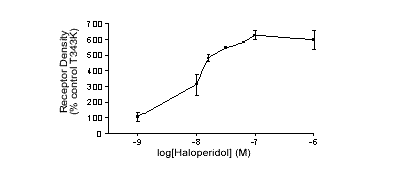| pA2
online © Copyright 2003 The British Pharmacological Society |
068P
University of Surrey Summer Meeting June 2003 |
|
Prolonged treatment of native mutant (T343K)D 2 SHORT dopamine receptors with the inverse antagonist haloperidol results in an increase in receptor intensity D.J. Franks, B. Gardner1 & P.G. Strange, School of Animal & Microbial Sciences, University of Reading, Reading, RG6 6AJ and 1Pfizer Global R&D, Sandwich, Kent, CT13 9NJ. |
Print abstract Search PubMed for: |
Mutating threonine343
to lysine (T343K) in the C-terminal region of the third intracellular
loop of the D2S dopamine receptor results
in a receptor with very low expression. This region is known to be involved
in restraining the receptor in its inactive conformation (Kjelsberg et al., 1992), therefore the low expression may be due to the receptor
being a constitutively active mutant (CAM). It has been suggested by Smit
et al., (1996) that prolonged exposure with inverse agonists can
significantly increase the expression of CAMs, therefore this theory was
investigated here.
CHO cells stably expressing human D2S
or D2ST343K dopamine receptors were treated
with vehicle or the D2 inverse agonist
haloperidol (Wilson et al., 2001) for 24hours, and then extensively
washed to remove any bound ligands before membrane preparation. Saturation
binding experiments were performed on membranes (10µg) with [3H]spiperone
(5pM-2nM) to determine the number of receptors (Bmax)
as in Gardner et al., (1996). Statistical significance was determined
using an unpaired Student's t test.

Table 1. Saturation
analysis of native and mutant D2S receptors,
and the effects of 24hr treatment with an inverse agonist. Data represent
mean ± s.e.mean *p<0.002, **p<0.001 (vehicle vs. treatment).
The basal expression levels for D2S and D2ST343K receptors were significantly different (Table 1), which indicated some kind of instability of the mutant receptor, either during synthesis or once at the cell surface. Treatment with haloperidol (100nM) for 24hours resulted in a significant increase in the expression of both D2S (134%) and D2ST343K (637%) (Table 1). Haloperidol was also shown to have a dose-dependent effect on the expression of D2ST343K (Fig. 1).

Fig. 1. Effect
of increasing haloperidol concentrations on D2ST343K
receptor expression. Data represent mean ± s.e.mean (n![]() 3).These
data show that haloperidol significantly increases the expression of both
D2S and D2ST343K
dopamine receptors. It is possible that there are two mechanisms of action
involved: 1) stabilisation of receptors at the cell surface by promoting
their inactive states, 2) assisting with protein folding during synthesis,
thereby 'chaperoning' receptors to the cell surface that would otherwise
be targeted for degradation.
3).These
data show that haloperidol significantly increases the expression of both
D2S and D2ST343K
dopamine receptors. It is possible that there are two mechanisms of action
involved: 1) stabilisation of receptors at the cell surface by promoting
their inactive states, 2) assisting with protein folding during synthesis,
thereby 'chaperoning' receptors to the cell surface that would otherwise
be targeted for degradation.
Kjelsberg M.A. et al., (1992) J. Biol. Chem. 267,
1430-1433.
Smit M.J. et al., (1996) Proc. Natl. Acad. Sci. USA. 93,
6802-6807.
Wilson J. et al., (2001) J. Neurochem. 77, 493-504.
Gardner B. et al., (1996) Br. J. Pharmacol. 118,
1544-1550.
We thank the BBSRC and Pfizer for their financial support.